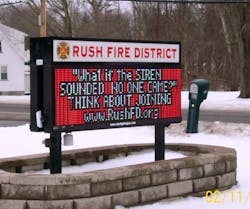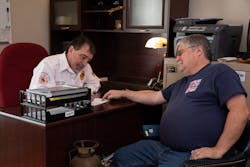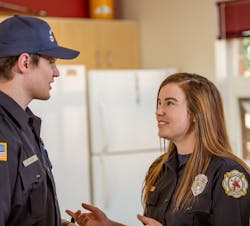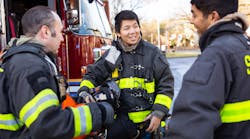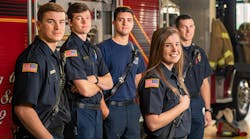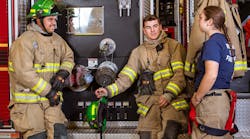This article is part of a larger supplement titled Recruiting and Retaining: The Future of Volunteer Fire Departments. View the supplement in its entirety here.
Over the past 30 years, the volunteer fire service has recognized that we are struggling with numbers. Calls have increased threefold, while volunteer numbers are either stagnant or dropping. Either way, fewer volunteers are handling more emergency incidents. To pile on, the mission of the volunteer fire service has expanded, particularly in the area of EMS.
What the numbers tell us
In large part, we have been looking at this problem as a “recruitment issue.” It certainly looks like one. According to the National Fire Protection Association (NFPA), between 1980 and 2010, the number of volunteer firefighters fell to 768,150 from 884,600. In 2017, the NFPA reports that there were approximately 682,000 volunteers, which is the lowest number on record.
However, recruitment really is just a symptom. The truth is that, in small and very small towns, the problem that we face is deeper than recruitment. It’s about the demographics and economic health of these towns overall.
Consider that, according to a National Volunteer Fire Council (NVFC) study, many millennials, women and minorities are willing to volunteer in the fire service. If that’s the case, where are they? Try the nearest city.
Young people are moving to urban areas from rural, and, as a result, small towns are struggling and even dying. In the past 10 years, the urban populations in this country increased to between 83 percent and 85 percent of the overall population. Contrast that with 1980, when the urban population represented about 70 percent of the population.
What’s more, the urban population continues to grow at an estimated rate of 0.9 percent per year. Vermont and Maine are the only two states that are posting numbers that might suggest that urban growth is slowing down.
Even as the younger people leave small towns, retirees are moving in, looking for small, scenic and lower-cost places to settle. In my small Massachusetts community, 30 percent of the people are older than age 60 (of 3,200 total). This is about double the percentage of over-60s statewide. In the United States overall, according to the U.S. Department of Agriculture (USDA) 2018 “Rural America at a Glance” report, rural counties make up nearly 85 percent of all counties, and more than 20 percent of rural county residents are older than age 65.Look around you. Are most of the volunteers who are in your town government older than age 50? Are they older than age 60? Is your town having trouble finding library volunteers, elected officials and new blood to help with the Fourth of July celebration? Are there half as many businesses in town as there were two decades ago? Are your banks and stores owned locally or nationally?
Fifty-three percent of fire and rescue volunteers are older than age 40, and the “new wave” of potential volunteers simply doesn’t live where we need volunteers.
No easy solution
At this point in any article that poses a problem, readers naturally would expect to see a proposed solution. The fact is that urbanization isn’t an easy issue to tackle. The volunteer fire service isn’t going to address urbanization alone. My sense is that, to see a sustainable uptick in fire and rescue volunteers, we must think and act long term. To do so effectively, we must collaborate closely with our local and regional chambers of commerce, the National Rural Economic Development Institute and the USDA, just to name a few. This is about all of us.
It’s likely, for example, that in communities that have attracted high-tech industries, the fire service will see a follow-on boost in the number of recruits. That’s not a one-size-fits-all solution, though. Many community leaders talk about the potential of attracting high-tech industries, but few have been able to follow through. The go-to move (tax incentives) isn’t enough if the workforce lacks college education and there isn’t fast, reliable broadband.
Local, regional and national entities must work together to set and prioritize steps to make individual communities more attractive to the rising generations. In the short term, though, we can’t stand by. We must pull out all of the stops to staff up our departments.
For starters, we need to recruit more women ... now. How many women does your department currently have? If the number is between 5–10 percent of your total number of volunteers, that’s typical, but it isn’t acceptable.
Look at your marketing efforts. Are you doing all that you can to recruit women? Look at your department culture. Are there any women in leadership positions? Why not? Look also at the practicalities of what volunteering is like for women at your department. Are there separate and adequate changing and sleeping areas?
We also can improve our marketing efforts overall. There’s an excellent, free tool at your disposal, and if you aren’t using it, you should. It’s the NVFC’s “Make Me A Firefighter” campaign. You can learn more about it at makemeafirefighter.org.
We also must acknowledge that small- and very-small-town fire departments don’t look like or operate like their cousins in the suburban and urban world. Smaller staffs, less money and greater distances between stations means a different level of service, and a different, yet-to-be-invented deployment method is needed. Yes, in the traditional model, we need 12–17 firefighters to battle a working house fire, but the fire service must come to grips with the reality that in some places, fighting fires with six firefighters is the only option. We need to figure out how to provide some reasonable level of service and to safely fight fires with only six firefighters in those small towns that lack resources. Just saying “You can’t do that” doesn’t help. One starting place for developing such solutions is the NVFC. Join it, push the issue and help brainstorm a new model.
Regionalization also is a possibility. The “watch out” here is that merging two or more weak fire departments might end up simply creating one larger weak fire department that doesn’t provide better services. Also, merging departments that have long distances between them doesn’t really improve the capability to get resources to a fire in a meaningful time frame. It may help to regionalize from an administrative standpoint, but it’s essential to scope out whether (and how) such a move can improve response times and staffing any better than a robust and well-organized automatic aid system.
Additionally, we can scrutinize our department bylaws and other rules. Are we imposing impractical residency and membership requirements? What about property-ownership requirements? Do we have to vote on new members? Do we turn people away because of arbitrary “caps” or recruiting schedules? I’ll grant you that these practices are going away, but institutional and social barriers still are preventing new people from joining the volunteer fire department. We need to be sure that qualified and/or trainable new members don’t face barriers.
Then there are management issues. The NVFC found that poor leadership is one reason that people quit or fail to join volunteer fire departments. Many departments have acknowledged this issue, and it’s waning; however, it still is a significant deterrent.
The dynamics that are associated with family-run departments also can be a negative. Community leadership needs to step in and break up the monopoly that some families seem to exercise over the local volunteer fire company. When people who aren’t part of the family show up at the station, they can’t get the cold shoulder, or they won’t volunteer for long. When the fire chief complains about not getting enough volunteers, but most of the department comes from three families, the recruitment problem might be an organization that’s too personal or too familial. This doesn’t mean that you must get rid of the dominant families, it just means that families need to be aware of how they are perceived and work to be perceived as more inclusive.
The bigger issues of demographics aren’t going away soon, and we do need to get involved in developing solutions at that level. There still is plenty that we can do to improve recruitment on our own today.
About the Author
Joseph Maruca is chief of the West Barnstable, MA, Fire Department, which is a combination fire department on Cape Cod. He served as a volunteer firefighter from 1977 until becoming chief in 2005. He is a Massachusetts director on the National Volunteer Fire Council (NVFC), serves as the vice chair of the NVFC’s recruitment and retention committee, and represents the council on the NFPA 1917 Technical Committee.
Joseph V. Maruca
Joe Maruca is chief of the West Barnstable, MA, Fire Department, which is a combination fire department on Cape Cod. He served as a volunteer firefighter from 1977 until becoming chief in 2005. He is a Massachusetts director on the National Volunteer Fire Council (NVFC), serves as the vice chair of the NVFC’s recruitment and retention committee, and represents the Council on the NFPA 1917 Technical Committee.

